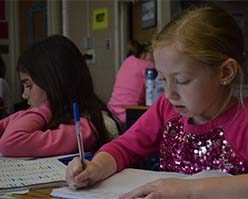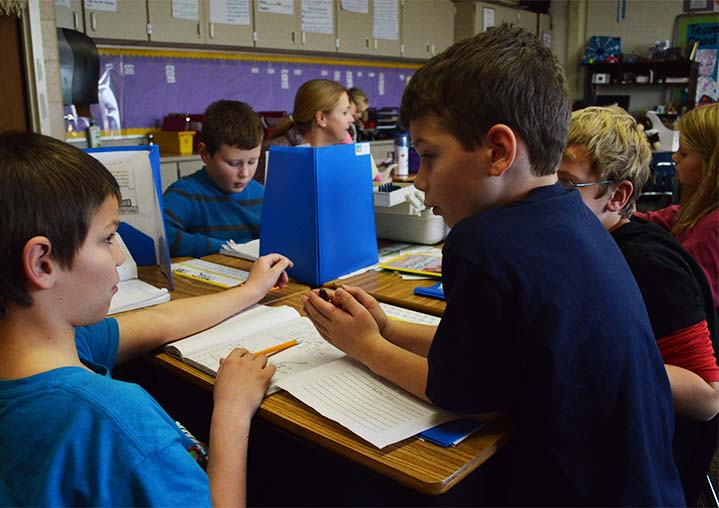Nicholas Wentworth was stuck. He wanted to write about his fish tank but didn’t know how to start it. His classmate Kaleb Harper came over to help.
“You’re writing about fish, right?” Kaleb asked Nicholas. “Do you know what the lead is? Maybe you could write a lead about how the fish needs that stuff to keep it alive.”
When Nicholas made a nibbling motion with his hand to show how fast his fish eats his food, Kaleb exclaimed, “That’s great! That’s a lead!”
As Nicholas and Kaleb continued their mini-consult, 28 other students put pen to paper in Kelly Goad’s third-grade classroom at Beach Elementary School. Students coaching students is part of what works in this intensive writing program adopted this fall by K-5 teachers in Cedar Springs Public Schools. 
Teachers in other Kent ISD districts also are using methods of The Reading & Writing Project, a program of the Teachers College at Columbia University to help young students become better and more enthusiastic readers and writers.
At Beach Elementary, the project’s curriculum has been formally folded into a long-standing writing workshop aimed at helping students express their lively imaginations with words on the page.
“I really just want them to gain a passion for the craft,” said Goad, a 10th-year teacher. “I want to break it down into attainable pieces, and have them fall in love with literature and where it can take them.”
Writing Like the Wind
Goad tries to instill a love for writing by incorporating methods of The Reading & Writing Project founded byLucy Calkins, a children’s literature professor at Teachers College and the author of several books widely used in K-5 classrooms. The project conducts research and provides curriculum and training institutes for teachers.
 Goad was one of several teachers from Cedar Springs and Northview who attended an institute last summer. Though she’s used some of Calkins’ methods for years, Goad said her newly implemented lessons provide students with writing examples and goal sheets that help them learn skills and techniques.
Goad was one of several teachers from Cedar Springs and Northview who attended an institute last summer. Though she’s used some of Calkins’ methods for years, Goad said her newly implemented lessons provide students with writing examples and goal sheets that help them learn skills and techniques.
Teaching writing to third-graders is a ball, she says. “They amaze me every day, what they remember, the funny things they can share, how excited they are,” Goad said.
If enthusiasm generates excitement, she gives her class plenty to work with. On a recent morning, she began the hour-long writing workshop with a challenge to write as many lines as they could in 5 minutes. “I want to see smoke!” she shouted. “Go!”
Brooklyn Colclasure set to work intently, beginning a dramatic story as music played in the background: “Ahh, I screamed. There was something on my head. I wanted to run …” 
When time was up, Brooklyn smiled proudly. She had written 10 lines.
“Thank you for writing like the wind,” Goad told the class.
Three Ways to Start a Story
These short bursts of writing are basic to the workshop. So are long chunks of time to develop their ideas and techniques.
On this morning, Goad stressed the importance of a strong start to a paragraph or chapter with a statement, question or one-word lead sentence. Students read story passages and offered possible leads, then paired up to discuss leads for the informational essays they were working on. Goad set them free to work on the essays for half an hour, roaming the class to offer pointers as they wrote.
“One time we went to go to Florida,” wrote Reid Brandimore. “It was fun.”
Ayden Crouch wrote about different kinds of war planes, including a glossary of terms. “I like to write a lot because it calms me down,” Ayden said. “Even if everybody’s talking, I would still write and I wouldn’t listen.”
 Josie Kenyon also wrote intently, as if blocking everything else out. “Ideas just come to me,” she explained.
Josie Kenyon also wrote intently, as if blocking everything else out. “Ideas just come to me,” she explained.
Meanwhile, Kaleb Harper was working with Nicholas Wentworth on an essay about how he takes care of his fish. They decided “needs” was a key idea, since the fish needs Nicholas to take care of it.
Goad came by and helped him flesh out the idea. What does the fish need? she asked. A filter, Nicholas said. How could you put that into a lead? she asked. Nicholas listened quietly, then began writing: “PU! Have you ever seen a tank so dirty? …”
CONNECT








